#Rhinoceros sondaicus
Explore tagged Tumblr posts
Text
Creature Awaits #212
Each week I plan to feature an amazing creature, admiring God's fantastic artistry. Hopefully it’ll brighten someone’s day to see something new and interesting if they haven’t seen it before. : )

(Taken approx. 1900 A.D, Photographer Unknown (Public Domain Mark 1.0))
The Javan Rhino
Scientific Name: Rhinoceros sondaicus
Region: While their range used to spread from Bhutan and far east India southward through Java, Indonesia, they now only exist in a tiny region of western Java.
Size: About 10' (3m) long and 4.6'–5.6' (1.4m–1.7m) tall at the shoulder
Interesting Notes: Sadly, rarest of all 5 species of Rhinoceros, only about 60-70 are thought to be left in the wild - all located within the Ujung Kulon National Park in Java. They are so endangered that even scientists will rarely seek them out for study as they do not want to risk interfering as they, hopefully, start to regrow their populations. It's also a tricky situation as they do not hold up well in captivity - with the oldest attempted captive rhino living only to age 20, and none ever being able to breed. However, it's not all sad news… Thankfully, very strict conservation laws are finally in place for them, and they do appear to still be breeding in the wild as two adults walking alongside their calves were caught on a motion-triggered camera, so hopefully someday they will thrive again.
#creatureawaits#beautiful animals#endandered species#Javan Rhinoceros#Rhinoceros sondaicus#rarest Rhino#animals of Java#Indonesia
1 note
·
View note
Text

Javan rhinoceros Rhinoceros sondaicus sondaicus
Observed by roylesafaris, CC BY-NC
102 notes
·
View notes
Text

Javan rhinoceros (Rhinoceros sondaicus)
160 notes
·
View notes
Text




Wood Engraving Wednesday
Abigail Rorer
I have long been a fan of the work of Massachusetts wood engraver, letterpress printer, and book artist Abigail Rorer (b. 1949). A former student of Barry Moser and inspired by the work of Leonard Baskin, Rorer is a part of what I call the Pioneer Valley School of artists, an interconnected group of artists and artisans who live, work, or trained in the Connecticut River valley region of western Massachusetts, centered in the Amherst/Northampton area.
I am particularly interested in Rorer's attention to detail, precision of mark making, and her fine lines, all of which are evident in this lovely engraving of a Javan Rhinoceros (Rhinoceros sondaicus). The original, signed print is one of several prints included in the Wood Engravers' Network (WEN) 2022 Printers Bundles sent in the fall to WEN members along with that year's issue of the society's journal Block & Burin. An over 20-year run of both the journal and the bundles was recently donated to Special Collections by Wisconsin WEN member Tony Drehfal.
I selected this print to post not only because Rorer is one of my favorite wood engravers, but also because the rhinoceros is my very favorite mammal (they are exquisite and beautiful!) and it pains me how endangered all species of rhinos are around the world. This print may become among last visual representations of this magnificent being before it is erased from our planet, or more hopefully, it may be one of the images that marks the revival of Rhinocerotidae.

View more posts on work by Abigail Rorer.
View more engravings by members of the Wood Engraver’s Network.
View more posts with wood engravings!
-- MAX, Head of Special Collections
#Wood Engraving Wednesday#wood engravings#wood engravers#women wood engravers#Abigail Rorer#Wood Engravers' Network#WEN#Tony Drehfal#Javan Rhinoceros#Rhinoceros#Rhinos#WEN Printers Bundle#Pioneer Valley School
17 notes
·
View notes
Text
Badak Bercula Satu: Keajaiban Alam yang Terancam Punah, Menyimpan Misteri dan Kekuatan Alam sebagai Salah Satu Satwa Langka yang Melambangkan Keberagaman Hayati dan Tantangan Konservasi Dunia

SELENGKAPNYA
Badak bercula satu, atau yang lebih dikenal dengan nama badak Jawa (Rhinoceros sondaicus), adalah salah satu makhluk langka dan eksotis yang hidup di alam liar, dan juga menjadi simbol kekayaan biodiversitas Indonesia. Dengan tubuh besar dan kuat, serta cula tunggal yang menjadi ciri khasnya, badak bercula satu adalah salah satu satwa yang paling mengesankan dan misterius di dunia. Badak ini hanya dapat ditemukan di Pulau Jawa, Indonesia, tepatnya di Taman Nasional Ujung Kulon, yang menjadikannya salah satu spesies yang sangat terancam punah. Keberadaannya yang semakin terbatas menjadikan badak bercula satu sebagai ikon dari tantangan besar dalam upaya pelestarian spesies dan lingkungan hidup.
Badak bercula satu adalah spesies yang unik, tidak hanya karena penampilannya yang garang dengan tubuh besar dan cula tunggal yang mencolok, tetapi juga karena gaya hidupnya yang relatif penyendiri dan terisolasi. Mereka hidup di hutan tropis yang lebat dan sering kali bersembunyi di balik pepohonan besar, menjadikan mereka sulit untuk ditemukan dan dipelajari. Badak ini menghabiskan sebagian besar waktunya dengan merumput di padang rumput dan mencari makanan seperti rumput, buah, dan daun-daun muda. Meskipun tampaknya lambat dan tidak terlalu aktif, badak bercula satu adalah makhluk yang sangat tangguh, dengan kulit tebal yang melindungi tubuhnya dari serangan predator alami.
Namun, meskipun tampilannya yang kuat dan perkasa, badak bercula satu menghadapi ancaman yang sangat serius. Populasinya yang semakin menurun, akibat perburuan liar dan hilangnya habitat alami mereka, membuat badak bercula satu menjadi salah satu spesies paling terancam punah di dunia. Konservasi badak bercula satu kini menjadi prioritas utama bagi berbagai lembaga pelestarian alam, baik di tingkat nasional maupun internasional. Upaya untuk melindungi habitat mereka di Taman Nasional Ujung Kulon, di mana hampir seluruh populasi badak bercula satu tinggal, terus dilakukan dengan hati-hati. Taman Nasional ini berfungsi sebagai tempat perlindungan yang vital, namun ancaman terhadap badak tetap ada, baik dari perubahan iklim, penyakit, hingga risiko bencana alam.
Meskipun tantangan besar ini, terdapat harapan yang tumbuh dari upaya konservasi yang gigih. Berbagai program pemantauan dan perlindungan habitat terus dilaksanakan, serta upaya untuk meningkatkan kesadaran masyarakat tentang pentingnya menjaga keberadaan badak bercula satu. Pendekatan berbasis ilmu pengetahuan yang melibatkan para ahli biologi dan konservasionis juga memainkan peran penting dalam melindungi spesies ini dari ancaman kepunahan. Dengan keberhasilan konservasi yang tepat, diharapkan populasi badak bercula satu dapat pulih dan berkembang, mengingat bahwa mereka memiliki potensi untuk bertahan jika diberikan perlindungan yang memadai.
Badak bercula satu lebih dari sekadar simbol satwa langka; mereka adalah pengingat pentingnya peran kita sebagai manusia dalam menjaga keberlanjutan alam. Keberadaan mereka yang terancam punah menantang kita untuk lebih peduli terhadap lingkungan dan memahami betapa rapuhnya keseimbangan alam yang ada. Badak bercula satu, meskipun jarang terlihat, memiliki makna mendalam dalam ekosistemnya dan merupakan bagian dari warisan alam Indonesia yang harus dilestarikan dengan sepenuh hati. Jika kita gagal melindungi mereka, kita akan kehilangan lebih dari sekadar satu spesies; kita akan kehilangan bagian dari keanekaragaman hayati yang membuat planet ini begitu istimewa
0 notes
Text
Quel est le Rhinocéros le plus Rare?
Le Rhinocéros de Java (Rhinoceros sondaicus) appartient au genre Rhinoceros, faisant partie de la famille des Rhinocerotidae. Il constitue l’une des cinq espèces de rhinocéros encore présentes en Asie du Sud et en Afrique. De taille relativement réduite, le rhinocéros de Java est l’une des espèces les plus petites de rhinocéros, partageant cette caractéristique avec le rhinocéros de Sumatra. Ces…

View On WordPress
0 notes
Text
Fakta Unik Badak Banten di Ujung Kulon yang Spesiesnya Sangat Langka
PANDEGLANG – Badak Banten atau badak Jawa (Rhinoceros sondaicus) adalah salah satu hewan langka di dunia. Badak ini hanya hidup di Taman Nasional Ujung Kulon, Kabupaten Pandeglang. Berikut adalah beberapa fakta unik tentang badak Banten: Badak Banten merupakan spesies badak yang paling langka di dunia. Populasinya diperkirakan hanya tersisa sekitar 60 individu. Badak Banten memiliki kulit yang…
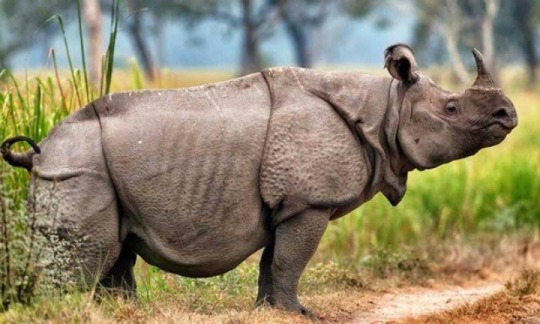
View On WordPress
0 notes
Text
Javan Rhinoceros

The Javan Rhino (rhinoceros sondaicus) is a Critically Endangered species that only occurs in Ujung Kulon National Park on the island of Java in Indonesia. There is only one population of 58-68 animals.

I have estimated that the effective population size is 19-22, because only approximately one-third of the population is reproducing.
The Javan rhino is expected to suffer from a loss of genetic diversity. The effective population size is too low to avoid inbreeding depression, and even in the best case scenario only 86% of its heterozygosity will remain. This is less than the value of 90%, which is generally considered to be the acceptable rate of genetic diversity loss.
Conclusion: the Javan Rhino will most likely suffer from genetic erosion.
Pic of a baby rhino called either Helen or Luther who were spotted last month in Ujung Kulon National Park:

Sources:
Fernando, P., Polet, G., Foead, N., Ng, L. S., Pastorini, J., & Melnick, D. J. (2006). Genetic diversity, phylogeny and conservation of the Javan rhinoceros (Rhinoceros sondaicus). Conservation Genetics, 7(3), 439-448.
Ellis, S. & Talukdar, B. 2020. Rhinoceros sondaicus. The IUCN Red List of Threatened Species 2020: e.T19495A18493900. https://dx.doi.org/10.2305/IUCN.UK.2020-2.RLTS.T19495A18493900.en
https://www.sciencealert.com/two-extremely-rare-javan-rhino-babies-spotted-in-indonesian-park
https://www.worldwildlife.org/species/javan-rhino
#Javan rhino#Javan rhinoceros#rhinoceros sondaicus#Java#Indonesia#ujung kulon#rhino#rhinoceros#animal science#ecology#animal ecology#conservation#animal conservation#animals
8 notes
·
View notes
Photo

Javan Rhinoceros (Rhinoceros sondaicus)
57 notes
·
View notes
Photo

Two newborn Javan rhinos spotted on camera in Indonesian park
With the birth of two new Javan rhino (Rhinoceros sondaicus) calves this year, the population of one of the world’s most endangered mammals continues to show signs of slow but stable growth, Indonesian officials announced on April 26.
The newborn calves were spotted on camera traps in Indonesia’s Ujung Kulon National Park, home to the sole remaining population of Javan rhinos. Video from February shows two different mothers, affectionately known as Puri and Dewi, accompanied by their babies. The sex of the calves is still unknown, and they are yet to be named.

Park officials also announced that park rangers found an adult male rhino dead on one of the park’s beaches on the morning of April 23. At present, officials believe the rhino, who was around 30 years old, died of natural causes.
From a confirmed population of 67 individuals in February, the tally of Ujung Kulon’s rhinos now stands at a minimum of 68: 29 adult males, 24 adult females and 15 juveniles.
Despite this positive trend, the species still faces a number of dangers. Once found throughout Southeast Asia, Javan rhinos are now confined to a single park at the westernmost tip of Indonesia’s Java Island. In addition to the threat of disease, poaching and other human incursions, recent research indicates that a large tsunami could wipe out virtually the entire species.
#javan rhinoceros#Rhinoceros sondaicus#critically endangered#tw: dead animals#Ujung Kulon#Indonesia#news
211 notes
·
View notes
Photo

Markas Pejuang Covid-19: Dari Juliana, Rancabadak hingga Hasan Sadikin Bandung, bewarajabar.com -- Sejak Covid-19 mewabah, salah satu tempat di Kota Bandung yang sering disebut, yaitu Rumah Sakit Umum Pemerintah Dr.
#Dr Paryono Suriodipuro#FK UNPAD#Het Algemene Bandoengsche Ziekenhuis#Het Gemeente Ziekenhuijs Juliana#Markas Pejuang Covid-19#pasien covid-19#Proklamasi 17 Agustus 1945#Rhinoceros sondaicus#Rigukun Byoin#rshs#Rumah Sakit Hasan Sadikin#Rumah Sakit Kota Juliana#Rumah Sakit Rancabadak#sejarah#W. J. van Thiel
0 notes
Text

Javan rhinoceros Rhinoceros sondaicus sondaicus
Observed by roylesafaris, CC BY-NC
10 notes
·
View notes
Photo

Rinoceros sondaicus. Lesser Indian rhino/Javan rhino. Scaled models available.1/5-1/10-1/15. #javarhino #sondaicus #rino #rhinoceros https://www.instagram.com/p/CFxlFRAjyUG/?igshid=1g2nnav0mjiq1
2 notes
·
View notes
Text
Hewan yang di Lindungi di Masing-Masing Pulau di Indonesia.
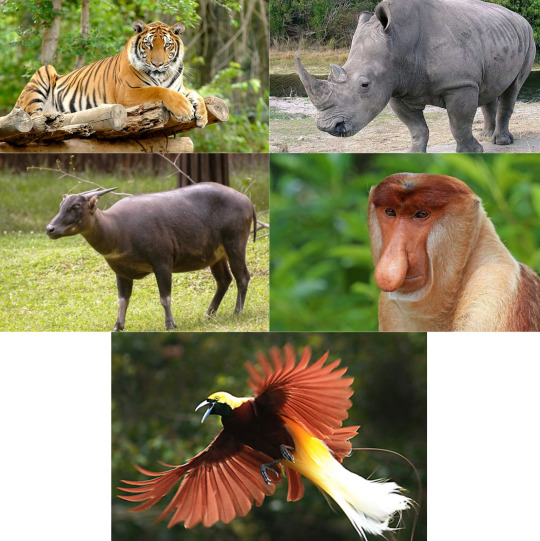
Banyak hewan-hewan endemik dari masing masing pulau di Indonesia. Contohnya, Sumatra dengan harimau nya, Kalimantan dengan orang utan nya, dan yang lainnya. Tapi tahu kah kamu hewan yang di lindungi atau hampir punah di masing-masing pulau di Indonesia? Mari kita bahas.
Harimau Sumatera (Pulau Sumatera).
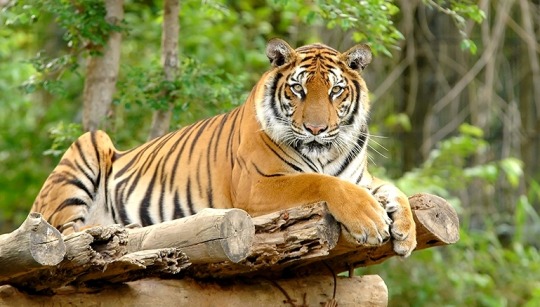
Sumber: kba.one
Harimau Sumatera (Panthera tigris sumatrae) merupakan harimau asli Pulau Sumatera yang memiliki ukuran tubuh lebih kecil dibandingkan jenis harimau lainnya.
Harimau Sumatera jantan memiliki berat sekitar 140 kg, sedangkan harimau Sumatera betina memiliki berat sekitar 91 kg.
Populasi harimau Satwa saat ini hanya tersisa 400-500 ekor sehingga mereka dimasukkan dalam daftar satwa kritis yang terancam punah.
Badak Jawa (Pulau Jawa).
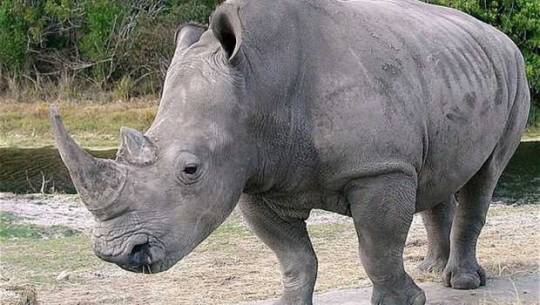
Sumber: beritasatu.com
Badak Jawa (Rhinoceros sondaicus) yang lebih dikenal dengan nama badak bercula satu ini merupakan satwa asli Pulau Jawa. Karena saat ini diperkirakan hanya tersisa 74 spesies, badak bercula satu menjadi salah satu hewan paling langka di Indonesia.
Adapun kemampuan reproduksi yang rendah dan perburuan yang tidak henti-hentinya dilakukan membuat hewan ini menjadi langka. Kini, badak bercula satu tengah berada di bawah perlindungan program konservasi intensif secara in-situ di Taman Nasional Ujung Kulon (TNUK).
Anoa (Pulau Sulawesi).
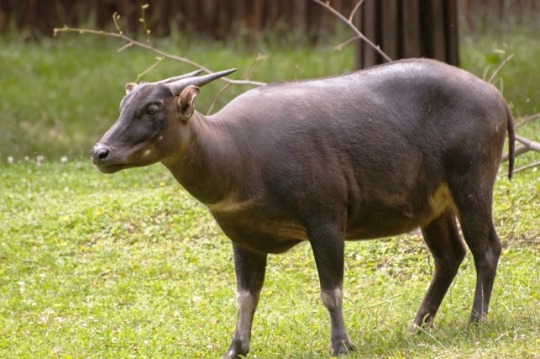
Sumber: Sultrakini.com
Anoa (Bubalus depressicornis) merupakan hewan endemik pulau Sulawesi yang memiliki dua macam spesies, yaitu anoa dataran rendah dan anoa pegunungan.
Anoa termasuk ke dalam hewan yang hampir punah. Mengapa anoa terancam punah? karena kebiasaan masyarakat sekitar yang berburu anoa untuk dikonsumsi hingga diambil bagian kulit dan tanduknya.
Hewan langka ini hidup di dalam hutan sehingga anoa tidak bisa menjadi hewan ternak meski memiliki kesamaan dengan hewan kerbau.
Bekantan (Pulau Kalimantan).
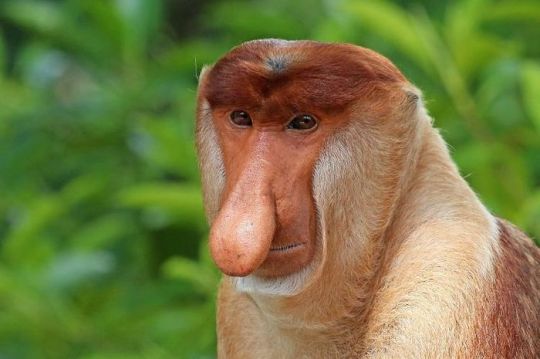
Sumber: prcfindonesia.org
Bekantan (Nasalis larvatus) adalah spesies mamalia yang tergabung dalam kelompok primata dan memiliki habitat di Pulau Kalimantan. Di wilayah Kalimantan Timur, spesies bekantan mendiami wilayah Sungai Hitam di wilayah Samboja, Kutai Kartanegara. Bekantan juga dijuluki monyet berhidung panjang karena memang hidungnya terlihat unik.
Keberadaan bekantan juga sangat memprihatinkan akibat perburuan liar, penebangan hutan, dan perusakan habitat alam liar. Itu sebabnya, spesies bekantan menjadi salah satu spesies hewan yang sangat dilindungi oleh pemerintah Indonesia, bahkan oleh IUCN.
Yang membuat sedih adalah jumlah bekantan yang benar-benar sangat sedikit di alam liar. Menurut data yang ditulis dalam laman Cambridge, jumlah populasi bekantan di alam liar yang hidup mandiri hanya sekitar 300 ekor. Bekantan merupakan spesies yang rentan stres, bahkan mereka bisa mengalami kematian mendadak meskipun sedang berada di tempat penangkaran.
Burung Cendrawasih (Pulau Papua).
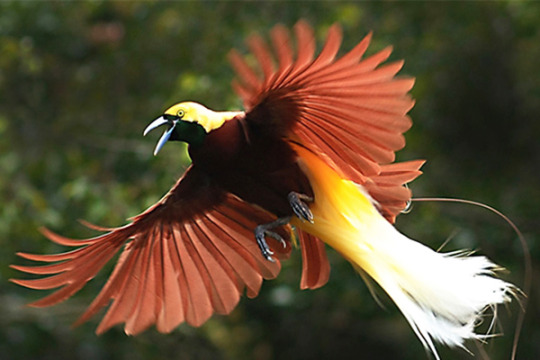
Sumber: kabarpapua.co
Burung Cendrawasih Merah (Paradisaea rubra).Dikenal sebagai burung surga karena keeksotisannya, Cendrawasih Merah corak bulu dominan berwarna merah, dengan aksen hijau, kuning, dan hitam pada bagian kepalanya.
Berdasarkan data, Burung Cendrawasih Merah tergolong ke dalam jenis hewan yang hampir terancam di habitat aslinya, yakni Pulau Waigeo dan Batanta.
Dikutip dari: berbagai sumber.
4 notes
·
View notes
Text

Javan Rhinoceros
Rhinoceros sondaicus
Source: Here
158 notes
·
View notes
Text
Rhinos in China: Though rhinos are currently extinct in China, here are some new-ish maps and research on the surprisingly widespread distribution of rhinoceros species living in China during recent historic times, prior to large-scale human geoengineering and environmental change
*Spins wheel* Uhhh today’s hyperfixation is: distribution maps, just like every day. But this time, it’s maps related to East Asian environmental history and the anthropogenic extinction of rhinos. Or whatever. Have this stupidly long and completely unsolicited post, I guess.
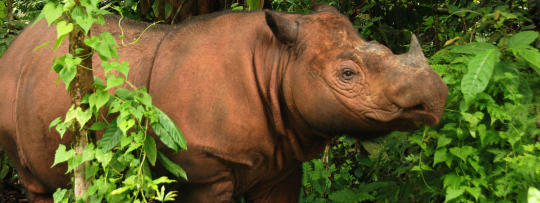
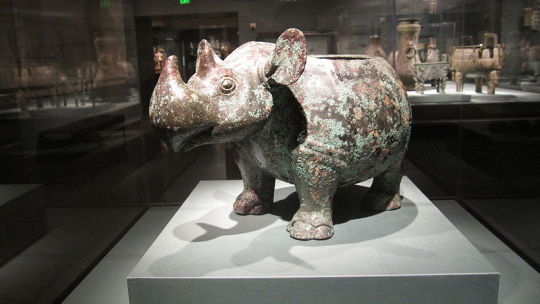
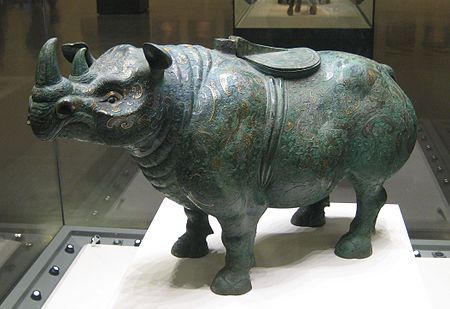
Today, rhinos are extinct in China. The presence of rhinos in China during historical times - and the scale of their distribution range - has been a bit ambiguous, at least to Western/European audiences, though Chinese art and scholarship has long incorporated rhinos. Though modern, living rhinos seem to be associated with tropical and subtropical biomes in the popular consciousness, the Sumatran rhinoceros (Dicerorhinus sumatrensis) apparently didn’t mind the seasonal snow and cold of temperate climates. About only 3,000 years ago, the Sumatran rhino was apparently still present throughout most of China, as far north as modern Beijing; even as recently as 100 AD, this rhino was probably still present as far north as Shanghai.
The phrase “retreat of the elephants” has sometimes been used to describe the process of human-caused environmental change and landscape alteration that dramatically remade the Chinese landscape over the past 3,000 years especially. (”Retreat of the elephants” is a term borrowed from environmental historian Mark Elvin.) It is relatively well-known that Asian elephants (Elephas maximus), which at the beginning of major Chinese state-building and irrigation projects about 3,000 years ago still lived as far north as Beijing, were gradually driven further and further south, away from the Yellow and Yangtze rivers. Recent research, though, shows that Sumatran rhinos also suffered a similar fate. A “retreat of the rhinos” if you will.
The two rhinoceros figurines pictured above are pieces from ancient China. The first image is in the public domain and depicts a rhino-shaped ritual wine vessel made of bronze, from about 1100 to 1050 BC, during the Shang era. The piece is housed at the Asian Art Museum of San Francisco, The second image is another bronze wine vessel from a site in Shaanxi Province, this time inlaid with gold and hailing from later in history during the Western Han period, about 205 BC to 10 AD. [Photo by Wikimedia user Babel/Stone.] The rhinos in both of these pieces are depicted with two horns, meaning that they likely depict the Sumatran rhinoceros; this is corroborated by the existence of fossil remains of Sumatran rhinos from across China prior to 1000 AD. [The header photo above depicts a living Sumatran rhino on the island of Sumatra. Photo by Bil Konstant and International Rhino Foundation.]
Here behold a Sumatran rhino - and a calf! [At Sumatran Rhino Sanctuary on the far southeastern edge of the island. Photo by S. Ellis, via PBS.]
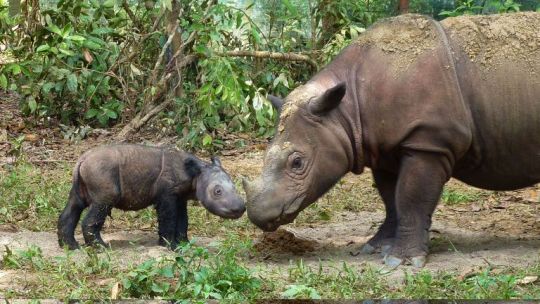
A Sumatran rhino. [Photo by Mark Carwardine and WWF.]
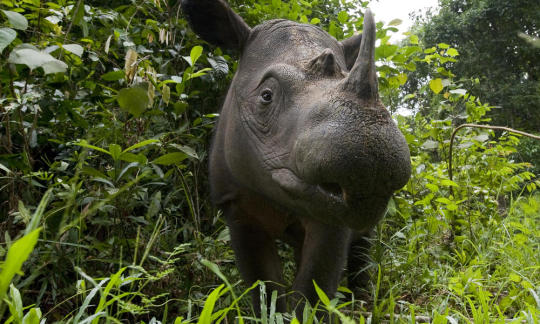
-
Here are some maps and other recent research resources about 3 of the rhinos living in China in recent history.
At the end of the last Ice Age of the Pleistocene about 11,500 years ago and during the advent of so-called agricultural civilization, China was apparently still home to at least 3 species of rhino: the woolly rhinoceros (went extinct around this time); Javan rhinoceros; and, by far the most widespread species, the Sumatran rhinoceros. (To be fair, it is proposed that a 4th species - the famous Indian rhinoceros, Rhinoceros unicornis, now the most relatively stable of the Asian rhino species - was potentially historically present in small pockets of China’s Yunnan Province up until the 20th Century.)
(Rhinos don’t observe arbitrary human-made national borders. I don’t like observing national borders especially when discussing biogeography and ecoregions, so here I’m referring to “China” as the geographic space which was in the cultural sphere of influence of a Chinese dynasty/state between the Shang era and the early 20th Century; centered on the Yellow and Yangtze rivers; and basically including landscapes north of Vietnam, east of Tibet/Taklamakan, and south of the Gobi Desert.)
-
Woolly rhinoceros (Coelodonta antiquitatis)

This is a reconstruction of a woolly rhinoceros, housed at the Natural History Museum in London. Photo by Emoke Denes.
Here’s a distribution map of known sites where woolly rhinos still lived in the Late Pleistocene (up to about 11,500 years ago), at the time that humans were planting and domesticating food crops.

This map comes from a neat report on Late Pleistocene megafauana and ecology in China: “Three abrupt climatic events since the Late Pleistocene in the North China Plain” from Lin Jingxing et al., 2013.
Woolly rhinos may have died out around this same time at the end of the Pleistocene (11,500 YBP), a little too early to have been depicted widely in Chinese art. (Some radiocarbon dates of woolly rhino remains in nearby Siberia, however, suggest the rhino could have persisted into the Holocene until the climatic reversal of the Younger Dryas period, about 10,000 YBP or 8,000 BC.)
-
Javan rhinoceros (Rhinoceros sondaicus)
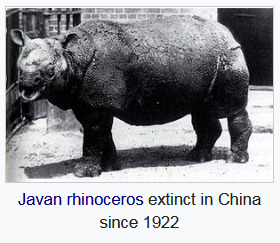
[Thank you, Wikipedia.]
There are less than 100 Javan rhinos that still exist, living only in Ujung Kulon National Park on the far western tip of Java. Here’s the distribution range of the Javan rhinoceros in recent history before its terrible decline [map by Wikimedia user JayHenry]:
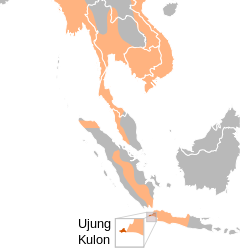
During the past 150 years, the Javan rhino still lived all across Southeast Asia, from India and Bangladesh through Vietnam and into Indonesia. Historically, the Javan rhino likely used to live along the southern China coast west of Guangzhou and Hong Kong. Since the species seems to prefer humid tropical environments, it’s unlikely that the Javan rhino lived any farther north into China during historic times.
-
Sumatran rhinoceros (Dicerorhinus sumatrensis)
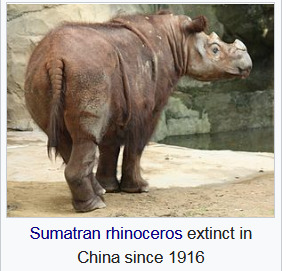
[Thanks again, Wikipedia.]
Here we are. Unlike other rhino species which either went extinct during the Pleistocene or only occupied the humid, tropical southern fringes of China, the Sumatran rhino lived throughout most of China. This is the species likely depicted in historic Chinese art and from which rhino-hide armor was made. Occasional poems from early China also seemingly make reference to the presence of rhinos.
Here’s the current distribution of the Sumatran rhinoceros, contrasted with the early 20th Century distribution [map by Wikimedia user Jay/Henry, adapted from Foose 1997 and Dinerstein 2003]:
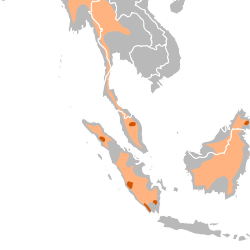
Note that the Sumatran rhino currently lives nowhere near China. Until 1916, the Sumatran rhino had lived in Yunnan Province in far southern China along the Myanmar and Indian borders with China. This map is misleading, however, since the Sumatran rhino was present across the majority of China during “historic” times. Recent Chinese scholarship confirms that the Sumatran rhinoceros was much more widespread across China before 1000 AD.
During the past 3000 years, the Sumatran rhino evidently lived as far north as Beijing, in northern China. Here’s a map of recovered Sumatran rhino fossils throughout China, including an approximation of their distribution range over time.
The real historic distribution of Sumatran rhinos in China:
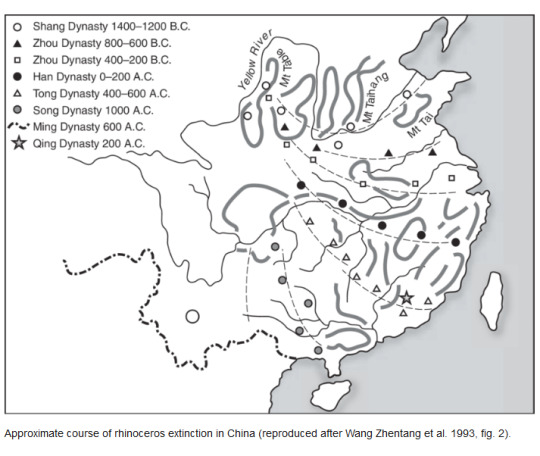
I edited the map a little:
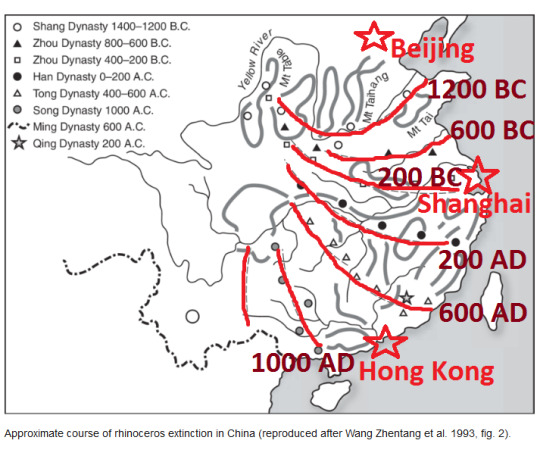
During the Shang era (1400-1200 BC), Sumatran rhinos were still present near Beijing and the Yellow River. By the famous Han Dynasty and the so-called unification of a Chinese “empire” around 50 AD, Sumatran rhinos had been pushed south to about the Yangtze River and Shanghai. By about 1000 AD, the species had been pushed farther south, near Guangzhou and Hong Kong.
This map uses fossil presence of Sumatran rhinos to approximate the historic extent of their distribution in China. The map comes from a great summary of the historic distribution of rhinos in China: “Distribution and extinction of the rhinoceros in China: review of recent Chinese publications” from Kees Rookmaaker, published in Pachyderm, 2006.
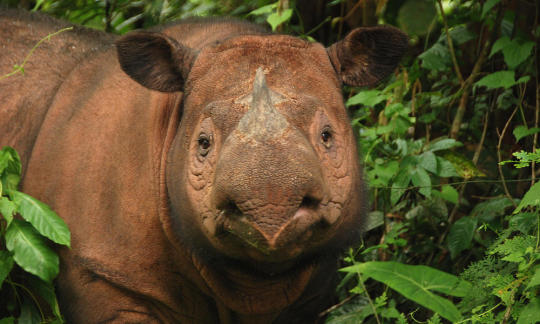
[A Sumatran rhino. Photo by Sumatran Rhino Sanctuary via WWF.]
Check out this link to read more about the history of rhinos in China.
Thank you for participating in this hyperfixation.
117 notes
·
View notes